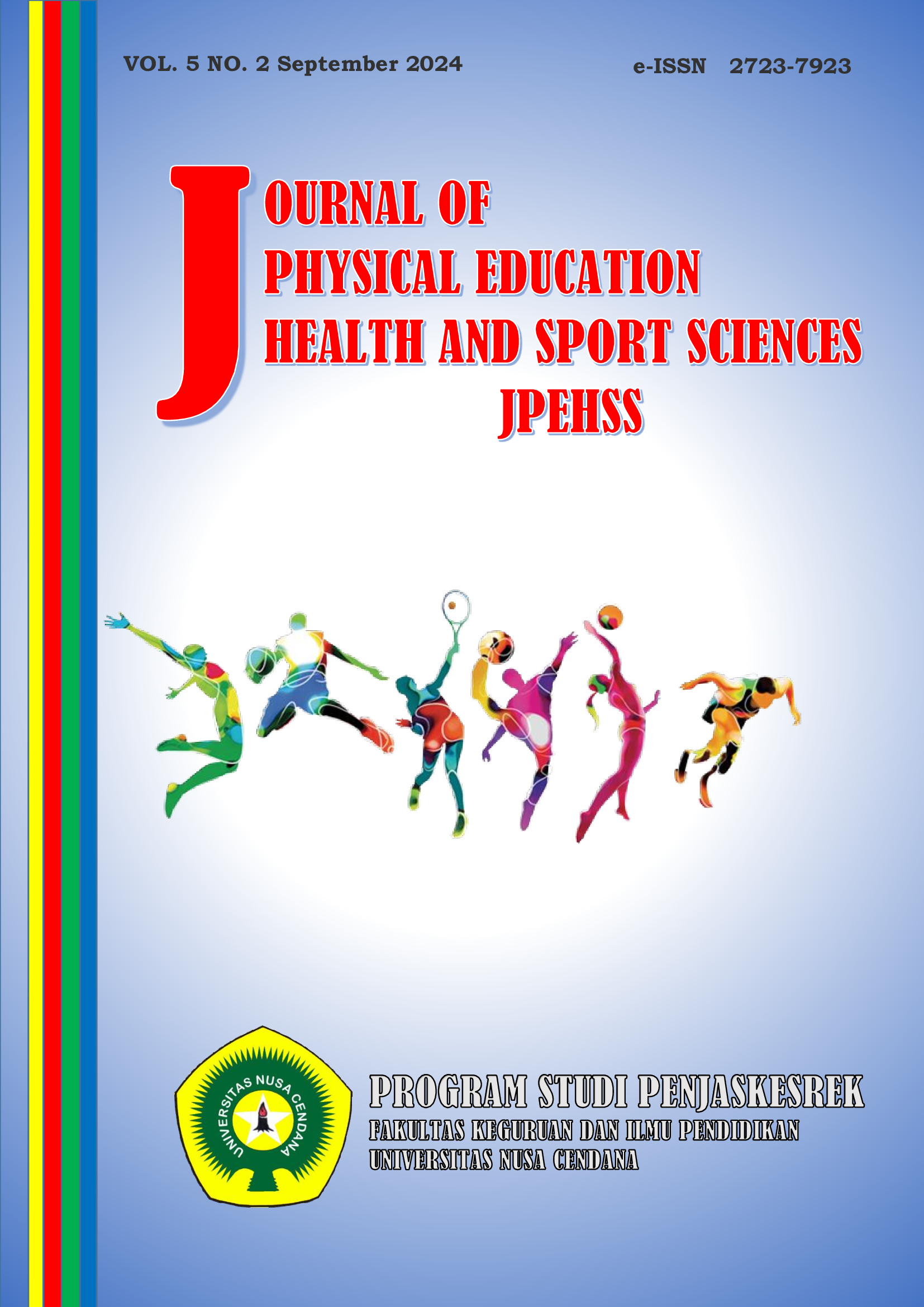PENGARUH LEG PRESS TERHADAP PENINGKATAN KEKUATAN TUNGKAI KAKI ATLET TAEKWONDO DOJANG PPO KUPANG
Abstract
Consists of three words, namely Tae, kwon and do. Tae means feet or crushing with the feet. So, if interpreted simply, a good kicking technique in the martial sport of taekwondo is influenced by the position of the feet, body balance, waist and angle when lifting the knees, so that you can get a hard and right-on-target explosion.
This research method uses a quantitative method based on the philosophy of positivism, used to research certain populations or samples, data collection using research instruments, quantitative/statistical data analysis, with the aim of testing predetermined hypotheses.
The results of the t-test can be concluded that the comparison of the results of the Leg Muscle Strength training of Taekwondo Dojang PPO Kupang City Athletes after training obtained a t-test value that was greater than before training with a calculated t value of 5.06 at a = 5% with db = 11 -1 =10 to get t(0.975)(10)=2.18
Based on the results of research data calculations and discussions, it is known that there is an influence, so the conclusions that can be drawn are as follows: There is an influence of leg press training to increase the leg muscle strength of Taekwondo Dojang PPO Kupang City athletes. Based on the t-test above, it can be concluded that the results of the comparison test of leg press training to increase the leg muscle strength of Taekwondo athletes' legs, this means that weight training using the leg press gives better results than without using the leg press.
Downloads
References
Ariansyah, A., Insanistyo, B., & Sugiyanto, S. (2017). Hubungan Keseimbangan Dan Kekuatan Otot Tungkai Terhadap Kemampuan Tendangan Dolly Chagi Pada Atlet Ukm (Unit Kegiatan Mahasiswa) Taekwondo Universitas Bengkulu. Kinestetik: Jurnal Ilmiah Pendidikan Jasmani, 1(2), 111-116.
Arifin, J. (2017). Spss 24 Untuk Penelitian Dan Skripsi. Elex Media Komputindo.
Budiman, A. F. (2014). Perbedaan Sudut Tolakan Terhadap Nilaikekuatan Tungkai. Medikora, 13(1), 154212.
Fadli, Z. Perbedaan Pengaruh Latihan Lompat Gawang Dan Naik Turun Tangga Terhadap Daya Ledak Otot Tungkai Pada Atlet Ekskul Anggar Man 2 Model Medan Tahun 2018. Jurnal Ilmu Keolahragaan, 17(2), 62-72.
Fatoni, M. (2012). Perbedaan Pengaruh Latihan Kombinasi Teknik Sprint Dan Latihan Kombinasi Teknik Zig-Zag Terhadap Kecepatan Tendangan Clurit Pesilat Putra Jpok Fkip Universitas Sebelas Maret Surakarta Tahun 2012.
Hernowo, A. (2017). Perbedaan Pengaruh Latihan Box Jump Dengan Latihan Depth Jump Terhadap Kekuatan Otot Tungkai Atlet Taekwondo Hasaku Stabat 2017 (Doctoral Dissertation, Unimed).
Huba, E. (2019). Kontribusi Daya Ledak Otot Tungkai Terhadap Kecepatan Tendangan Sabit Siswa Ekstrakurikuller Pencak Silat Sma Pgri Pekanbaru (Doctoral Dissertation, Universitas Islam Riau).
Indrayana, B. (2012). Perbedaan Pengaruh Latihan Interval Training Dan Fartlek Terhadap Daya Tahan Kordiovaskuler Pada Atlet Junior Putra Teakwondo Wild Club Medan 2006/2007. Cerdas Sifa Pendidikan, 1(1).
Karo-Karo, A. A. P., Sari, L. P., & Dewi, R. (2020). Pengaruh Latihan Plyometric Terhadap Kekuatan Otot Tungkai. Sains Olahraga: Jurnal Ilmiah Ilmu Keolahragaan, 4(2), 75-83.
Sukadiyanto, M. P., Suharjana, M. K., Awan Hariono, M., & Jatmika, H. M. Seminar Nasional Olahraga Tahun 2014.

 Elron Apriel Koroh(1*)
Elron Apriel Koroh(1*)














